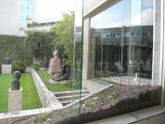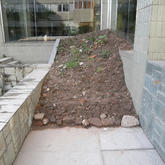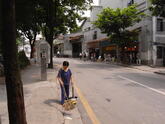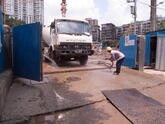Wake in Guangzhou: The History of the Earth, 2008
Installation
Some seeds arrive into the city by the movement of people. Guangzhou’s historically important port, in China trades with the world and this provides countless opportunities for the influx of seeds. Trains, cars, ships and animals also transport seeds. Wind and rain sweep seeds from one place to the other. Birds flying across the continents bring seeds.
A sample of earth was removed from Huagui lu, a street in the Liwan District, the former merchant quarters of Guangzhou. It was the only city through which foreigners were allowed to enter China and the Liwan District, the only place in China that foreigners were allowed to live in.
The earth sample was placed in the courtyard of the Guangzhou Contemporary Art Museum and the dormant seeds previously buried in deep layers germinated and plants grew. Meanwhile research uncovered the possibilities of seed carriers to the Liwan District. People, their travels, their friendships, lovers, the people they encountered at meetings, parties, festivals, the store they bought their groceries and clothes from, the horses or cars or buses they rode, the artists they met, the theatres they visited and what tea they drank and from where it was picked from and who picked it could potentially contribute to the seed bank at Huangui lu.
The plants that grow from the mound of earth can reflect the history of the site.
The mound of earth is a monument garden of past, present and future possibilities, of consequential and inconsequential encounters.
overview (PDF) about the whole project Wake in Guangzhou
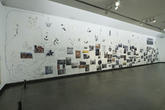
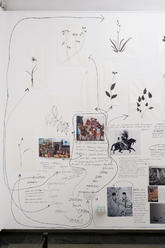

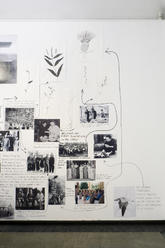
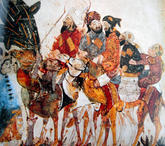
. The investigation of the arrival of seeds in Guangzhou began with Ibn Battuta, a Berber from Algeria. He was famously a world traveller in the 12th century, travelling to Damascus, Cairo, Bethlehem, Iraq, Aden, Zanzibar, Oman, Anatolia, the Maldives – where he married – and many other places before arriving in Guangzhou; seeds could have arrived with him from any of these places.

. Emperor Qianlong liked to have big birthday parties where foreign guests would arrive via Guangzhou, and then make their way to the capital. They came with lavish gifts, sometimes as extreme as elephants and giraffes. These animals could have had seeds from their home attached to their fur that could have fallen off when they disembarked.
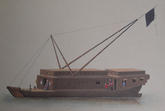
. Rice was imported into China through the port of Guangzhou; there are 60 different types of weeds that grow among the rice from Vietnam, any of which could have come to Guangzhou.

. Mr. Wu, a Chinese merchant with authorisation to trade with foreigners – and therefore an imminent seed mover – collected the work of the artist Tinqgua who had a studio in the foreign quarters. A business associate of Mr. Wu, Augustine Heard, who came from Massachusetts in the USA and had business dealings in Australia, also collected works by Tinqgua. This presented more opportunities for the arrival of seeds.
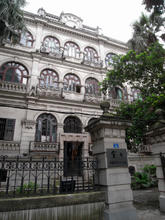
. Several European countries had consuls in foreign parts, including Germany, along with a map of how winds (and therefore perhaps floating seeds) circulated in the area around the former German colony of Tanzania, which could then have arrived with diplomats.
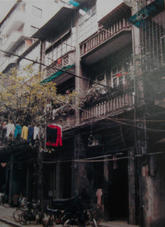
. Sun Yat–sen, the leader of the first Chinese Revolution, had a pharmacy just a few streets from the earth site. He had studied in Hawaii where he received an award from King Kalakava who was the first monarch to tour around the world. Sun then travelled throughout China, Asia and Europe to raise funds for the Chinese revolution and met many people like Silas Aaron Hardcon, who was from Iran but grew up in Bombay and moved to China. Sun met Mariano Ponce who was from the Philippines and studied in Madrid but fled for political reasons to France, Hong Kong and Yokohama; he later became a diplomat. The artist, He Xiagning, from Hong Kong, was a member of Sun Yat-sen’s central committee and travelled to the Philippines, Singapore, Sri Lanka, Paris and Germany and other places for her exhibits; seeds could have attached to her clothes and fallen in Guangzhou when she had meetings with Sun. The engineer Zhan Tianyu studied in Connecticut and traversed China building railroads; Sun met with him because he was curious about trains.

. Soong Ching-ling from Shanghai was a pilot who flew in the first airplane manufactured in China. She married Sun Yat-sen. Seeds could have arrived in Guangzhou from any of the couple’s or the airplane’s encounters. Soong started a magazine with Israel Epstein who was born in Warsaw and whose mother had been in exile in Siberia. The family then moved to Tientsin, after awhile he moved to Britain and returned to China at the invitation of Soong. He then travelled to Tibet and Beijing. As head of United Press, he met many foreign reporters. Soong also met with heads of state such as the Queen of Belgium; seeds from Belgium’s former colony, Congo, could therefore have arrived in Guangzhou.

. The historical documentation of Guangzhou ended with an image of Soong feeding pigeons… Ducks also hang out with pigeons to get some bread crumbs… Some ducks in Guangzhou travel from Europe to Africa… And they can bring seeds.
